List of Lord Shiva names with meaning (original, authentic names)
Namaste friends, how are you doing today? Welcome to #BhagavanBhakthi website / blog.
Bhagavan Lord Sri Vishnu (Krishna) (Rama) and Lord Shiva blessings to you and your family!
In this website / blog, you will always learn about #Hinduism #Sanskrit language.
Also subscribe to my YouTube channel from this link #BhagavanBhakthi to view videos about #Hinduism #Sanskrit language.
Just before going to “List of Lord Shiva names with meaning (original, authentic names)“, let us have some brief information.
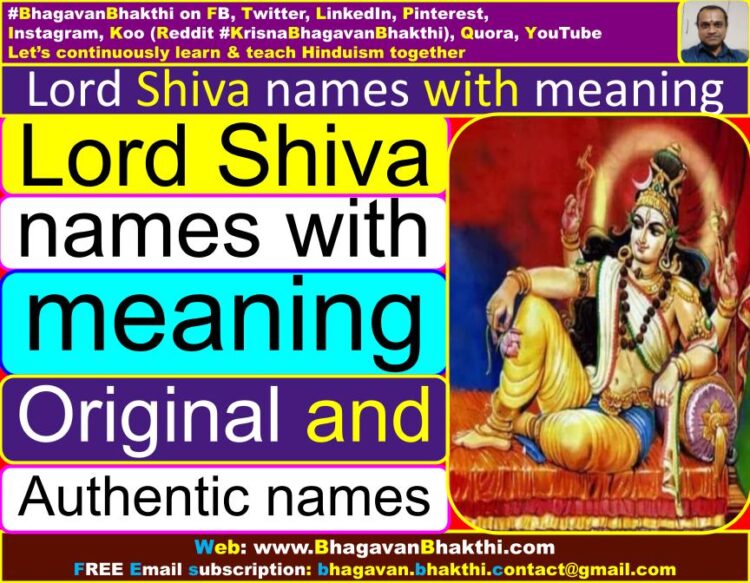
Lord Shiva was born from the ‘manasa’ (divine mind) of Lord Sri Brahma Deva. While Lord Sri Brahma Deva was born from the ‘nabhi’ (divine navel) of Lord Sri Vishnu.
Lord Shiva’s consort name is Goddess Sri Parvati Devi. Lord Shiva’s children names are Lord Sri Ganesha and Lord Sri Kartikeya.
The very important qualities of Lord Shiva are the sarpam / serpent Vasuki around his neck, the adorning crescent moon Sri Chandra Deva.
The most pious and holy river Ganga flowing from his matted hair (jata), the third eye (Trinetra) on his forehead, the Trishula / Trident as his weapon, and the Damaru (A divine drum).
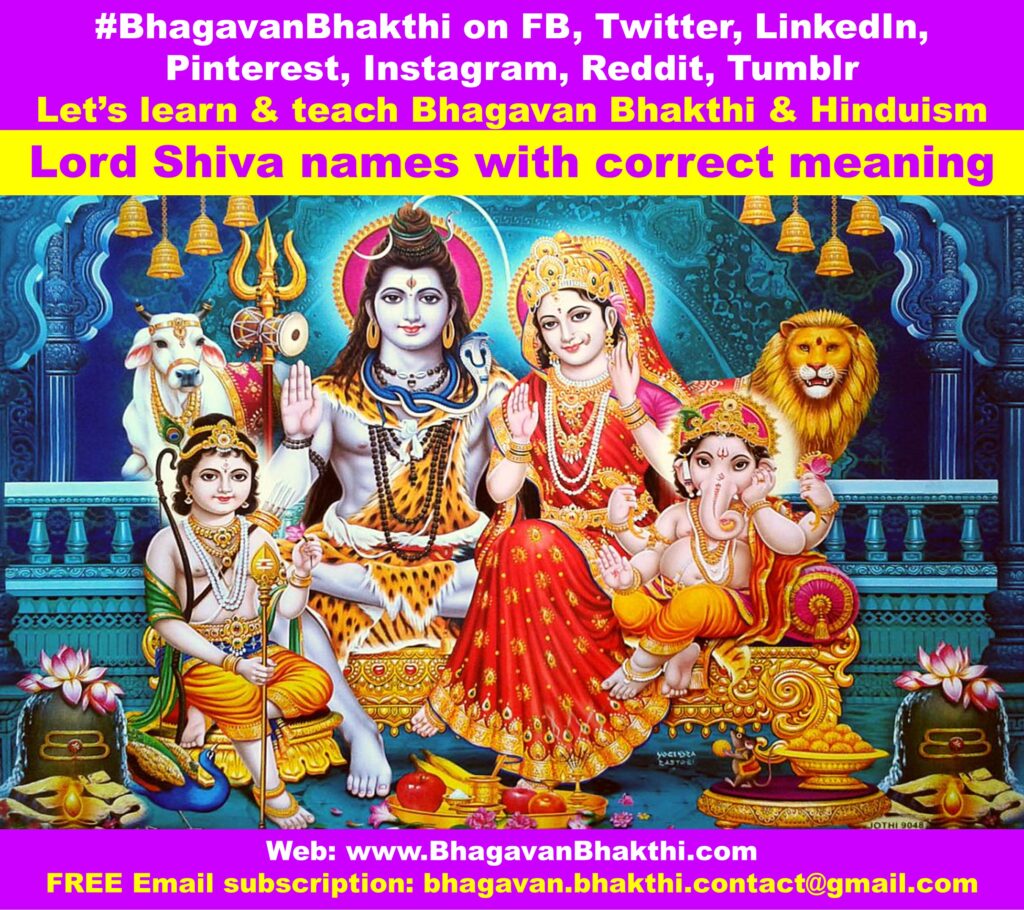
There are innumerable names of Lord Shiva. Let us today learn few of Lord Shiva names with correct meaning.
List of Lord Shiva names with meaning are as given below:
Andhakasura Hara : As Lord Shiva killed Andhakasura named asura (demon). In Sanskrit this name Andhakasura Hara is written as अन्धकासुर हर (andhakāsura hara).
Kamari : Lord Shiva burnt alive Lord Sri Kama Deva (Manmatha), when all the Devatas (Demigods) sent Lord Sri Kama Deva to break the penance of Lord Shiva,
Sri Kama Deva shot his ‘kaama bana’ (arrow) at Lord Shiva, which made Lord Shiva angry and he opened his third eye.
And thus Lord Sri Kama Deva was burnt to ashes immediately (Kaamaari – Kaama = Sri Kaama Deva, ari = killing). Lord Shiva is someone who destroyed the body of Lord Sri Kama Deva.
In Sanskrit this manme Kamari is written as कामारि (kāmāri).
Ashutosha : As Lord Shiva gives the boon very easily and early to all who do tapasya (penance) of himself (Lord Shiva). Here Ashutosha = Ashu + Tosha = Very easily or fastly + Granting.
In Sanskrit this name Ashutosha or Ashutosh is written as आशुतोष (aśutōṣa).
Nandi Vahana : Lord Shiva has Nandi as his vahana / vehicle / mount and thus Lord Shiva is known as Nandi Vahana. In Sanskrit this name Nandi Vahana is written as नन्दी वाहन (nandī vāhana).
Aghora : This is the roopa / form which Lord Shiva took to kill Tripurasuras (Three demons), that is, Tarakaksh, Vidhyunmali and Kamalaksha. In Sanskrit this name Aghora is written as अघोर (aghōra).
Chandrashekhara / Somashekhara : Lord Shiva has Lord Chandra on his forehead. Here Chandrashekhara = Chandra + Shekhara = Lord Moon + wearing as crown of the forehead.
Same meaning holds good for the name Somashekhara = Soma + Shekhara = Soma + Shekhara = Lord Moon + wearing as crown of the forehead.
In Sanskrit Chandrashekhara is written as चन्द्रशेखर (candraśēkhara) and Somashekhara is written as सोमशेखर (sōmaśēkhara).
Gangadhara : Lord Shiva always has Ganga on his head and thus the name Gangadhara.
Some poets, novelists have called Goddess Sri Ganga Devi as the wife of Lord Shiva, which is completely incorrect. Goddess Sri Ganga Devi was never the wife of Lord Shiva.
Goddess Sri Ganga Devi is the wife of Lord Sri Varuna Deva. Lord Shiva was holding her as she requested him to give some place in him.
and Goddess Sri Ganga Devi had ‘vishesha sannidhana’ (special presence) of Lord Sri Vishnu, as she is the Lord Sri Vishnu’s ‘paadodaka’ (taking birth from the paada / leg of Lord Sri Vishnu).
Meaning of the name Gangadhara = Ganga + Dhara = Goddess Ganga Devi + Holding. Lord Shiva holds Goddess Ganga Devi on his head and thus he is known as Gangadhara.
In Sanskrit Lord Shiva name Gangadhara is written as गन्गाधर (gaṅgādhara).
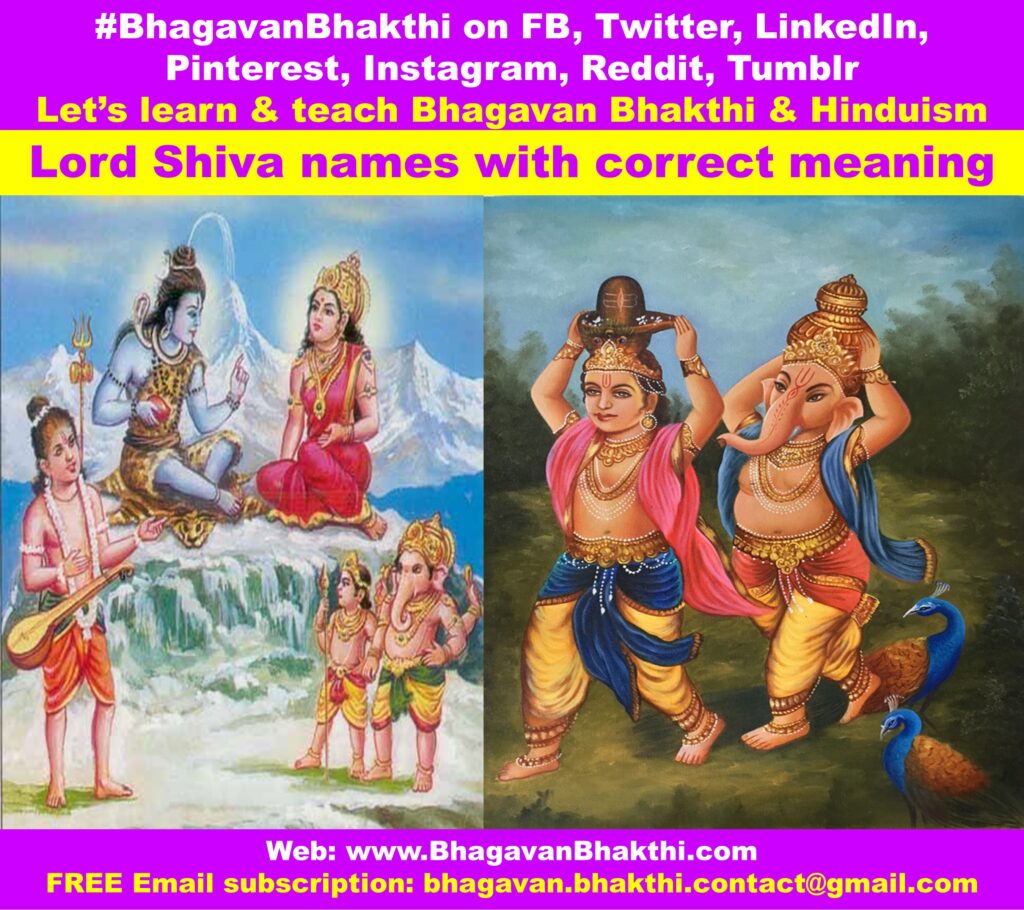
Damarugapani : Lord Shiva has Damaruga or Damaru in one of his hands, while doing tandava / dancing and thus Lord Shiva is called as Damarugapani.
The meaning of the name Damarugapani = Damaruga (Damaru) + Pani = Drum + Holding in his hand. Lord Shiva is someone who holds the Drum (Damaru) in his hand and thus he is known as Damarugapani.
In Sanskrit Lord Shiva name Damarugapani is written as दमरुगपाणि (ḍamarugapāṇi).
Gajasuramardhana : An asura (Demon) called Neela came in the disguise of an elephant as Gajasura (गजासुर), who entered the body of an elephant and attacked Lord Shiva.
Lord Shiva also entered the body of another elephant and did the ‘Tandava nritya’ (dance) there itself and killed the asura (demon) Gajasura from within the elephant.
Thus Lord Shiva is called as Gajasuramardhana (Gaja = elephant, asura = rakshasa / demon, mardhana = killing).
In Sanskrit Lord Shiva name Gajasuramardhana is written as गजासुरमर्धन (gajāsuramardhana).
Gajacharmambaradhara : Lord Shiva has killed an asura (Demon) named Gajasura by entering the body of another elephant and Lord Shiva was covered with the body of an elephant when Lord Shiva did the Tandava Nritya (dance).
Thus Lord Shiva is called as Gajacharmambaradhara (Gaja = elephant, charmambara = body (skin), dhara = holding).
In Sanskrit Lord Shiva name Gajacharmambaradhara is written as गजचर्माम्बरधर (gajacarmāmbaradhara).
Doorjati : Lord Shiva has Jata on this head and thus Lord Shiva is known as Doorjati (Durjati). Here Jata means matted hairs.
In Sanskrit Lord Shiva name Doorjati (Durjati) is written as दूर्जटी (dūrjaṭī).
Kailasavasa : Lord Shiva lives in Kailasa (Kailasavasa – Kailasa = Sky, vaasa = living). In Sanskrit Kailasa is the abode of Lord Shiva in the Himalayas.
Few people pronounce it as Kailash which is incorrect. In Sanskrit this is pronounced as Kailasa (कैलास (kailāsa).
In Sanskrit Lord Shiva name Kailasavasa is written as कैलासवास (kailāsavāsa).
Kritivasa : Lord Shiva wears ‘praani charma’ or animal skin as his dress and he is also called as Charmambaradhara for the same reason.
In Sanskrit Kritivaasa = Kriti + Vaasa = Skin + Wears as the cloth. Lord Shiva is someone who wears skin as his cloth and thus Lord Shiva is known as Kritivasa. Same holds good for the name Charmambaradhara.
In Sanskrit Lord Shiva name Kritivasa is written as कृतिवास (kr̥tivāsa) and Charmambaradhara is written as चर्माम्बरधर (carmāmbaradhara).
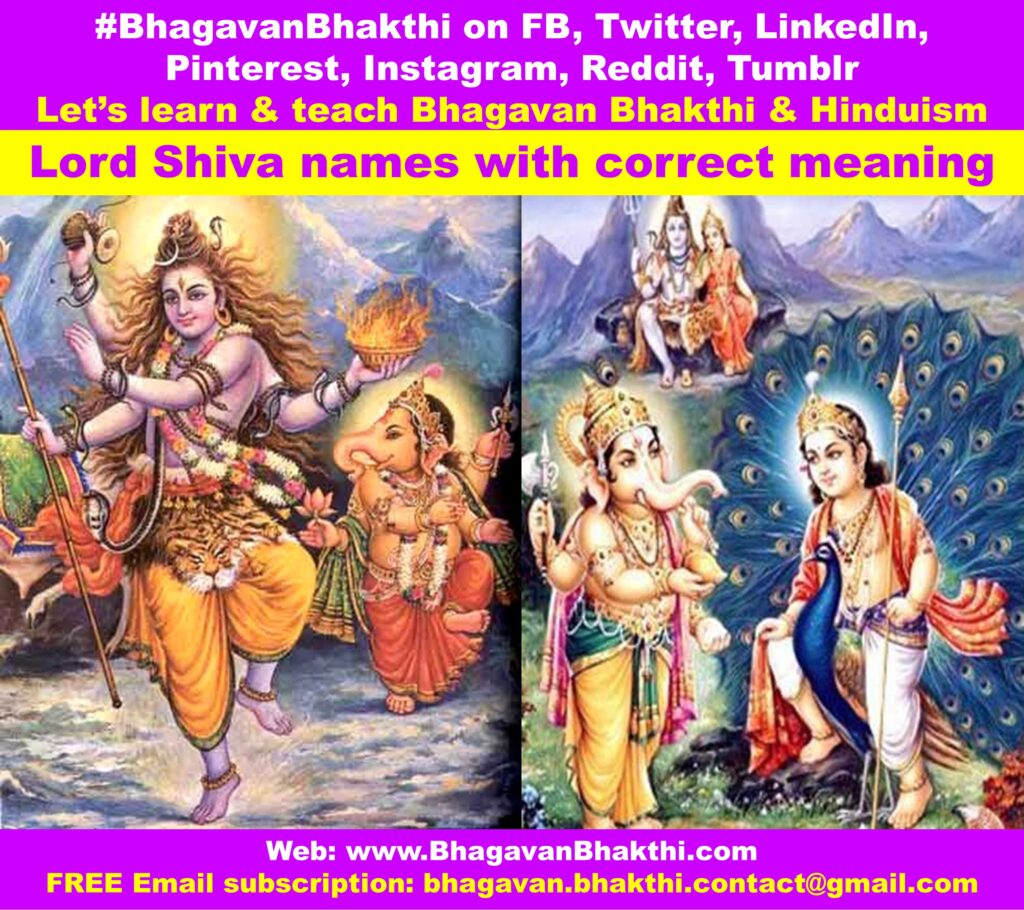
Manoniyamaka : Lord Shiva controls the chitta (mana / mind) of all the jeevis (living beings) starting from Goddess Sri Parvati Devi, Lord Sri Indra Deva and all the Devatas (Demigods) and others.
In Sanskrit Lord Shiva name Manoniyamaka is written as मनोनियामक (manōniyāmaka).
Maheshvara : Lord Shiva is superior to Goddess Sri Parvati Devi, Lord Sri Indra Deva, etc. that is, sakala / all devatas (Demigods).
In Sanskrit Lord Shiva name Maheshwara or Maheshvara is written as महेश्वर (mahēśvara).
Mrityunjaya : Lord Shiva has more power than the so called Mrityu Devata (God of death), that is, Lord Sri Yama Deva. Maharshi Markandeya had a very short life of only 16 years.
Thus, Markandeya was known that his life is very short. Thus, Markandeya worshipped Lord Shiva with utmost devotion.
After the completion of 16th year, Lord Sri Yama Deva came to take Markandeya’s life by pulling him with his arrows. Lord Shiva came and rescued Markandeya by fighting with Lord Sri Yama Deva.
After defeating Lord Sri Yama Deva, Lord Shiva blessed Markandeya with Chiranjeevatva (To live very long life). That is why Markandeya is considered as one of the Chiranjeevi.
And since Lord Shiva wins over Lord Sri Yama Deva, Lord Shiva is called as Mrutyunjaya – means someone who won against the Mrityu Devata, that is, Lord Sri Yama Deva.
In Sanskrit Lord Shiva name Mrityunjaja is written as मृत्युंजय (mr̥tyun̄jaya).
Nataraja : Lord Shiva is an expert in doing tandava – Naatya (Dance). Nataraja = Nata + Raja = Naatya (Dance) + King.
In Sanskrit Lord Shiva name Nataraja is written as नटराज (naṭarāja).
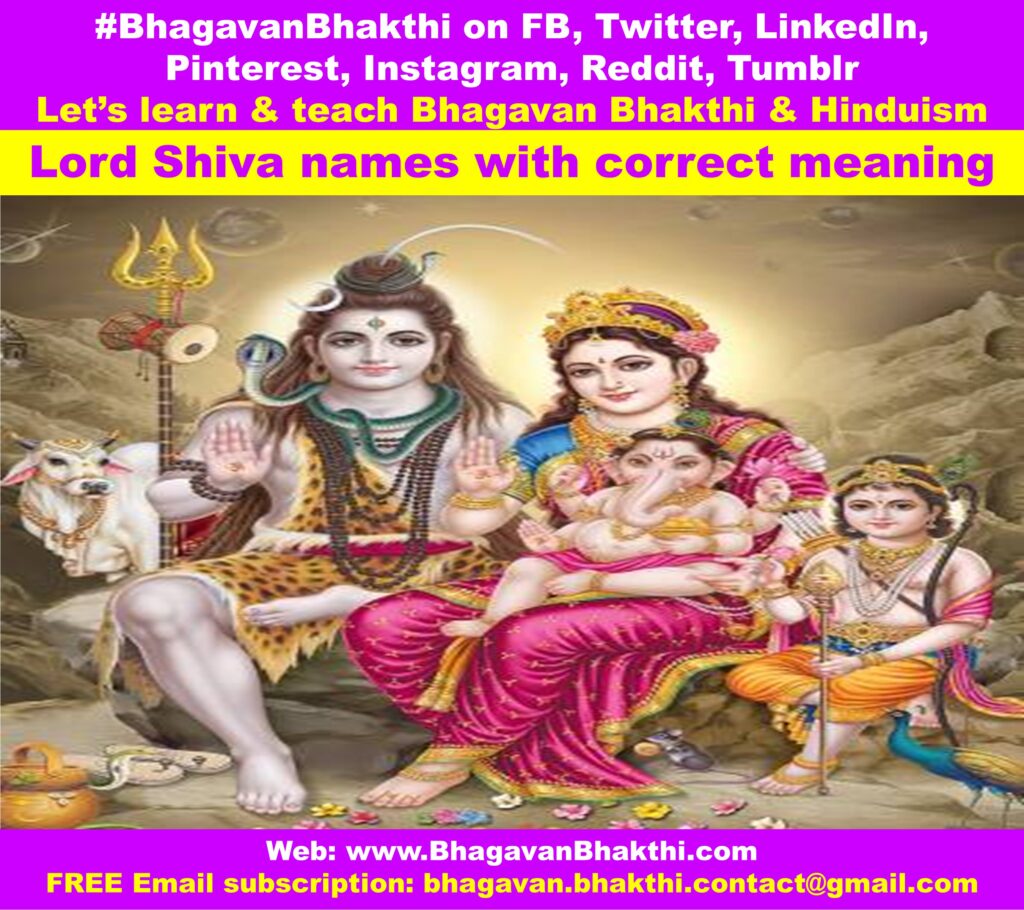
Nagabharana : Lord Shiva has sarpa (snake) as one of his ornaments. Nagabharana = Naga + Abharana = Snakes + Ornaments.
Lord Shiva wears snakes as his ornaments and thus Lord Shiva is also called as Nagabharana. In Sanskrit Lord Shiva name Nagabharana is written as नागाभरण (nāgābharaṇa).
Nagabhushana : Lord Shiva has sarpa (snake) around his neck and thus the name Nagabhushana. Nagabhushana – Naga = sarpa / snake, bhushana = wearing.
In Sanskrit Lord Shiva name Nagabhushana is written as नागभूषण (nāgabhūṣaṇa).
Neelakantha : Lord Shiva’s throat color turned blue after drinking hala hala visha (poison) when doing the amruta manthana (Samudra Manthan).
In Sanskrit Lord Shiva name Neelakantha is written as नीलकण्ठ (nīlakaṇṭha).
Parvatisha : Lord Shiva is the Isha / husband of Goddess Sri Parvati Devi and thus he is known as Parvatisha.
In Sanskrit Lord Shiva name Parvatisha is written as पार्वतीश (pārvatīśa).
Pinaki : Lord Shiva has pinaka (pinaaka) as his weapon (bow) and thus Lord Shiva is known as Pinaki. Pinaaki – Pinaaka = Pinaaka weapon, ki = holder.
In Sanskrit Lord Shiva name Pinaka is written as पिनाकी (pinākī).
Rudra : “Rodanaat Rudra” (रोदनात् रुद्र) (rōdanāt rudra). As soon as Lord Shiva was born he was crying continuously. That is why he is called as Rudra. Rodanaat – Rodana = crying, at = doing.
In Sanskrit Lord Shiva name Rudra is written as रुद्र (rudra).
Sadyojata : Lord Shiva was born all of a sudden from Lord Sri Brahma Deva’s mind and thus Lord Shiva is known as Sadyojaata (Sadyojata).
In Sanskrit Lord Shiva name Sadyojata is written as सद्योजात (sadyōjāta).
Sarangapani : Lord Shiva holds Saranga (deer) in his hands and thus Lord Shiva is known as Sarangapani.
In Sarangapani = Saranga + Pani = Deer + Holding in the hand. In Sanskrit Lord Shiva name Sarangapani is written as सारन्गपानि (sāraṅgapāni).
Shambhu : Lord Shiva is the source of Sukha (divine bliss) and also he is highly kind, thus Lord Shiva has the name Shambhu. In Sanskrit Lord Shiva name Shambhu is written as शंभू (śambhū).
Shankara : Lord Shiva gives “Sukha” (divine delight) and thus he is called as Lord Shankara. In Sanskrit Lord Shiva name Shankara is written as शंकर (śaṅkara).
Sharva : Lord Shiva is ‘laya karta’ (dissolution / end) with the blessings of Lord Sri Vishnu and thus Lord Shiva is known as Sharva. In Sanskrit Lord Shiva name Sharva is written as शर्वा (śarvā).

Shiva : Lord Shiva is mangalakara, that is, he is someone who gives all the good destiny / auspiciousness and thus Lord Shiva is known as “Shiva”. In Sanskrit Lord Shiva name Shiva is written as शिव (śiva).
Vamadeva : “Vaama or Vama” means highly sundara / handsome / beautiful. After Lord Sri Vishnu, Goddess Sri Lakshmi Devi, Lord Sri Brahma Deva, Goddess Sri Sarasvati Devi, Lord Sri Vayu Deva, Goddess Sri Bharati Devi, Lord Shiva is ‘atee-sundara’ (means very very beautiful and handsome).
That is why Lord Shiva is called as Vamadeva or Vaamadeva. In Sanskrit Lord Shiva name Vamadeva is written as वामदेव (vāmadēva).
Vamadeva : Another name of Lord Shiva is also Vaamadeva or Vamadeva, that is, Lord Shiva will always be at the left side of Lord Sri Vishnu.
That is why Lord Shiva is called as Vamadeva or Vaamadeva. In Sanskrit Lord Shiva name Vamadeva is written as वामदेव (vāmadēva).
Virinchiputra : Lord Shiva is the son of Lord Sri Brahma Deva (original name of Lord Sri Brahma Deva is Virinchi).
Brahma Deva is a rank and his orignal name is Virinchi. In Sanskrit Lord Shiva name Virinchiputra is written as विरिन्चिपुत्र (virin̄ciputra).
Vrishadhvaja : Lord Shiva has Vrishabha Dvaja, that is, Lord Shiva has the flag of the Vrishabha (animal) and thus Lord Shiva is known as Vrishadhvaja.
In Sanskrit Lord Shiva name Vrishadhvaja is written as वृषध्वज (vr̥ṣadhvaja).
Vishakantha : Lord Shiva drinks the left over of hala hala visha (poison) after majority of it was drunk by Lord Sri Vayu Deva and thus Lord Shiva is called as Vishakantha.
Lord Shiva’s throat (kantha) will be filled with visha (poison) and thus Lord Shiva is also called as Vishakantha. In Sanskrit Lord Shiva name Vishakantha is written as विषकण्ठ (viṣakaṇṭha).
Trishulapani : Lord Shiva has Trishula in one of his arms. Trishulapaani – Trishula = Trishula, paani = holder.
In Sanskrit Lord Shiva name Trishulapani is written as त्रिशूलपानी (triśūlapānī).
Tripurari : Lord Shiva killed Tripurasura (three demons) with the blessings of Lord Sri Vishnu. The names of Tripurasura are Tarakaksha, Vidhyunmali and Kamalaksha.
In Sanskrit Lord Shiva name Tripurari is written as त्रिपुरारी (tripurārī).
Trinetra / Trilochana : Lord Shiva has three eyes. In Sanskrit Netra and lochana means eyes. Since Lord Shiva has three eyes, he is called as Trinetra and Trilochana.
In Sanskrit Lord Shiva name Trinetra is written as त्रिनेत्र (trinētra) and Trilochana is written as त्रिलोचन (trilōcana).
Ugra : Lord Shiva is ‘shatru bhayankara’. Lord Shiva is very difficult to defeat by his shatrus / enemies / demons and thus he is known as Ugra. In Sanskrit Lord Shiva name Ugra is written as उग्र (ugra).
Ugratapas : Lord Shiva has done very very hard tapas (penance) for Kalpadi (कल्पादि) paryanta (whole of the Kalpa) for Lord Sri Vishnu and thus he is known as Ugratapas.
In Sanskrit Lord Shiva name Ugratapas is written as उग्रतपस् (ugratāpas).
Different avatars of Lord Shiva is as given here : Shukacharya, Durvasa, Ashwattama.
More information will be added to this on regular basis, please visit after some time to know more information.
To watch videos on #Hinduism #Sanskrit language, SUBSCRIBE to my YouTube channel from this below link:
#BhagavanBhakthi YouTube channel
Continue reading to know about “Lord Shiva (full) information (facts) (details) – Part 2 of 2” from this below link:
Lord Shiva (full) information (facts) (details) – Part 2 of 2
To know more names of Lord Shiva with meaning you can visit this link:
Lord Shiva names with correct meaning
To know more information on Lord Shiva and Shivaratri, you can visit this below link:
Lord Shiva, Shivaratri, other significances
To watch Modi chanting Har Har Mahadev secret | Importance of chanting Har Har Mahadev YouTube video, click the below YouTube video link:
Dear friends, if you need any clarifications about this post, kindly let me know, I will definitely try to answer all of them.
Also your one LIKE, one COMMENT, One Share, one SUBSCRIPTION is highly important.
This will help to know the quality of this content and also it will be helpful to know if any improvements is required for the content.
If you feel this content is useful to you and has helped you to improve your knowledge, kindly share this with your well-wishers.
Because “SHARING MEANS CARING”.
To receive FREE EMAIL SUBSCRIPTION about #BhagavanBhakthi, you can send an email to bhagavan.bhakthi.contact@gmail.com from your email ID.
NAMASTE!
Sri Gurubhyo Namaha
Sri Krishnaaya Namaha
Sri Krishnaarpanamastu
Share in Social Media